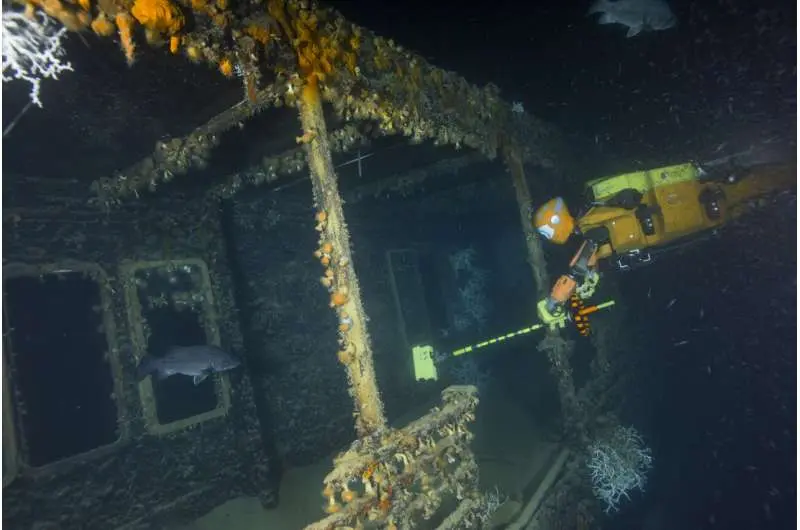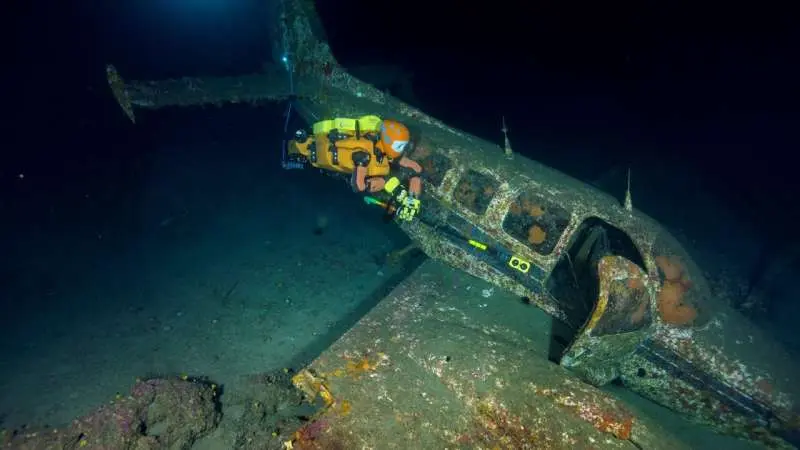Stanford University roboticist Oussama Khatib experienced a sense of presence when the underwater robot OceanOneK cautiously maneuvered near the top deck railing of the sunken Italian vessel Le Francesco Crispi this month, 500 m (about a third of a mile) below the Mediterranean’s surface.
humanoid top half and a slimmer back half with eight multi-directional thrusters that allow careful maneuvering underwater. The robot’s haptic—or touch-based—feedback system and stereoscopic vision produced incredibly realistic sensations that equaled what he would have experienced were he down below, rather than above onboard the control ship. Peering through OceanOneK robot’s eyes and feeling through its hands, Khatib perceived a kaleidoscope of life—pink and green and rusty-orange—layered on and around the ship. He felt the resistance of the water and could discern the shapes and proximity of the historic relic around him.
“You are moving very close to this amazing structure and something incredible happens when you touch it: You actually feel it,” said Khatib, who is the Weichai Professor in the School of Engineering and director of the Stanford Robotics Lab. “I’d never experienced anything like that in my life. I can say I’m the one who touched the Crispi at 500 m. And I did—I touched it, I felt it.”
OceanOneK’s voyage to these depths has two objectives: to explore previously unexplored territory and to demonstrate that human touch, vision, and interaction can be conveyed to locations that are far from where people can function.
The main achievement of the team, which included the crew of the ship, Denis Degez and Franca Cibecchini from DRASSM, Vincent Creuze from LIRMM at the University of Montpellier, Michel L’Hour, the former director of underwater archaeology research in France’s Ministry of Culture (DRASSM), and Michel L’Hour, was demonstrating functional autonomy at nearly 1,000 m below the surface. This development led to OceanOne’s rebranding as OceanOneK.
This is the first time a robot has been able to interact with the environment at such a level and let the human operator experience it, according to Khatib. It has been a fantastic journey,
First deep dig
February’s dive to the Crispi had been part of a multi-stop tour of the Mediterranean for OceanOneK that started in September 2021 with two stops near Marseille to a World War II P-38 Lightning aircraft at 40 m (about 130 ft) and a submarine, Le Protée, at 124 m (roughly 400 ft). The third was to a second-century Roman ship in Aléria, Corsica at 334 m (nearly 1100 ft) and the Crispi was next.
A search for suitable weather then urged the team toward Cannes. There, the robot’s boom camera had its first use in viewing inside the cockpit of a Beechcraft Baron F-GDPV aircraft that was 67 m down (over 200 ft). The final dive was to 852 m—over a half mile down—where, on pausing for a thruster check, the team found, worrisomely, that the robot was unable to ascend. OceanOneK was fully functioning but flotations around the communication and power line connecting to topside had collapsed, leaving the long, heavy line piled on top of the robot. Pulling in the slack, they were able to continue the dive.
Two OceanOne
OceanOneK robot’s expedition to the 1 km mark was long in the works. It started with countless hours of design, experimentation, and assembly with fellow team members in the lab, dozens of trips to the Stanford pool for debugging, and myriad lessons-to-be-learned before facing the unpredictability of the real world.
The predecessor of OceanOneK, OceanOne had been built for reaching depths at most around 200 m. To bring the robot deeper, the researchers adapted its body with special foam made of glass microspheres that provide buoyancy while being capable of withstanding the immense pressure at 1 km depths—pressure over 100 times the experience at sea level. Furthermore, the robot’s arms were filled with an oil and spring mechanism that compresses the oil to match the outside pressure, preventing collapse and cushioning the electronics. The researchers also updated many tiny components throughout OceanOne to minimize the amount of compressible air residing in individual parts and keeping the robot as compact as possible.
Two new types of hands were included in OceanOneK, one created by Stanford University researcher Mark Cutkosky’s team and the other by Professor Antonio Bicchi of the University of Pisa and the Italian Institute of Technology (IIT).
In a troubled mood
Over the past few years, swimmers at Stanford’s Avery Recreation Pool may have observed OceanOneK swimming while researchers experimented with various techniques and technologies. The equipment includes carrying crates for objects and a boom-mounted camera that would allow them to look inside confined and difficult-to-reach areas—areas where the robot couldn’t go.
The Stanford Robotics Lab graduate student Adrian Piedra remarked, “It was many months of testing, during COVID, twice a week, until everything—touch, control, and vision—worked without a hitch.”
Such planning was advantageous in many ways, but it was particularly helpful when the team’s first voyage required them to repair OceanOneK’s amputated limb. This necessitated disassembling the robot on the boat’s deck at night, in the wind, and during a storm, according to Khatib. Adrian Piedra and Wesley Guo, two of our brave pupils, never stopped trying to fix the robot. Everyone on board was astounded by their tenacity, tenacity, and ultimate triumph, according to Khatib.
“The robot has so many features and so many inter-related components that if there’s one part broken, we may need as much as a full day in dismantling, repairing, and reassembling,” said Stanford Robotics Lab graduate student Bo Kim, who traveled with OceanOne and collaborated from campus for OceanOneK. “Everything has to meld together and operate concurrently to achieve a good expedition, and that is very tough.”

The expedition in July
Following some issues with their initial trip, the crew received a second chance to dive to the Roman ship and the Crispi this summer. The team attempted—but failed to succeed—in removing an oil lamp from the Roman ship when they first came into contact with it. A malfunction with the arm prevented the boom camera from being used at the Crispi in February. For the dives in July, everything was in motion.
Under the direction of the team’s archeologists, OceanOneK dove to the Roman ship once more and was successful in bringing back a number of priceless antique vases dating to the Roman Empire, some of which had never been seen in DRASSM’s collections before. These discoveries were unusual because the manufacturer’s name and label were still visible on them, demonstrating the advantages of diligent super-deep artifact recovery.
Khatib dove to the Crispi again, this time extending the boom camera into the broken hull without touching the edges. He was led by the team’s marine biologist, who avidly watched as the external corals gave way to the inside rusticles, rust formations in the shape of icicles that revealed the results of nearly 80 years of bacterial contact with the ship’s iron.

both in the past and the future
Piedra claimed that in hindsight, he has started to comprehend the wider picture, how significant the difficulties they faced were, and how enormous the task they completed is.
We travel all the way to France for the expedition, and once there, among a larger group of people with diverse backgrounds, you realize that the component of the robot you’ve been working on at Stanford is actually a part of something much greater, he added. You can understand the significance of this, how innovative and momentous the dive will be, and what this means for science as a whole.
The OceanOne project incorporates cutting-edge developments in haptics, underwater robotics, and human-robot interaction. It also creates new opportunities for marine science and underwater engineering activities, such as inspecting and maintaining boats and infrastructure, such as bridge piers and underwater pipelines.
Other missions are planned in many different places throughout the globe, including lost towns buried beneath deep lakes, coral reefs, and archeologically significant wrecks at depths so far beyond human reach that OceanOneK presents a singular opportunity to comprehend the past.
Read More
- A secure global supply chain is possible with blockchain.
- Using electricity to locate materials that can “learn” is shocking to the system
- Cracking of Eggshells using computing power
- A Way To Help Reduce Global Warming Is Through Solar Energy Conversion



